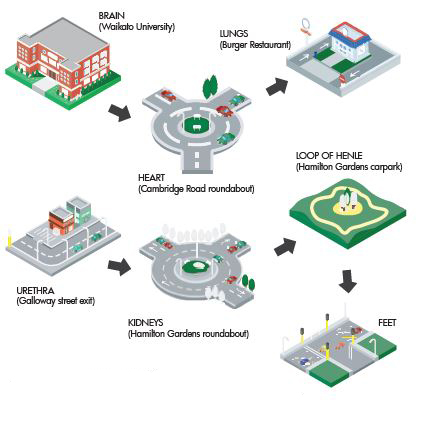Teaching pathophysiology to undergraduate nursing students is challenging because there is a need to apply theory into the everyday clinical reality of nursing patients.
Students may understand the abstract concepts but actually recognising pathophysiological changes when assessing a patient is another challenge. In this article, we present an example of everyday teaching moments using metaphors to provide a bridge between understanding the theory of pathophysiology and putting it into clinical practice.
Roundabouts and exits
MacKenzie teaches undergraduate nursing students at Wintec, including working with students on clinical practice placements in the third semester of
the degree.
This is the first time students undertake in-depth patient assessments and case studies and MacKenzie has noticed that they sometimes struggle to make meaning from the physiological patterns they encounter when working with patients.
MacKenzie bridges this gap using everyday ideas – or metaphors – that are familiar to students. Sometimes she might talk about the Starship Enterprise being under attack or a car breaking down, and other times about going shopping or traffic jams. The example we share here is traffic jams or congestion.
The idea of ‘traffic congestion’ came about when students were struggling to understand the mechanics of heart failure.
The aim of using a metaphor (see box) is to demystify the pathophysiology and bridge the student’s gap in understanding by using a practical example. Over time this metaphor has developed into a more comprehensive narrative, with nuances allowing for further clinical complications to be examined.
Using the experience of traffic congestion as an analogy for the pathophysiology of congestive heart failure calls on an everyday experience for many people living in cities.
Wintec’s home is Hamilton – the country’s fourth-largest city and home to more than 140,000 people. Traffic congestion is a problem, particularly around the south-east area of the city that contains the university and many schools. The main arterial route to the south is Cobham Drive (State Highway 1), which is dissected by various landmarks, secondary roads and roundabouts.
The Cobham Drive metaphor for heart failure
Students driving to class often experience traffic congestion, making the commute slow and difficult.
Various locations on the Cobham Drive route have been selected by Morag to represent anatomical locations so the causes and effects of congestive heart failure can be illustrated by what happens when the traffic (circulation) slows heading into the city. If the traffic backs up, the roundabouts get clogged – a good analogy for the backwards and forwards flow effects of congestive heart failure (CHF).

HEART (Cambridge Road roundabout)
Congestion and reduction in traffic flow at peak traffic times puts pressure on the flow and efficiency of the roundabout and roading. Does a larger roundabout help cardiomegaly or hypertrophy?
Restricted traffic flow due to close proximity of housing so traffic backs up in the roading system – like the backwards and forwards flow effects of congestive heart failure. What happens if passengers get out of the cars – pulmonary and peripheral oedema?
LUNGS (Burger store roundabout)
Students consider how the burger store’s drive-thru becomes congested with increased traffic at peak time. Customers now opt to go into the store to order instead. This can be viewed as pulmonary oedema – fluid accumulation into the alveoli/air sacs space.
The burger store is now experiencing congestion difficulties as it is unable to process orders because of the volume of foot and vehicle traffic – this is the lungs now experiencing dyspnoea, pulmonary oedema, increased respiratory rate, adventitious breath sounds and decreased gas exchange.
KIDNEYS (Hamilton Gardens roundabout)
Progression of traffic through roundabout is limited with reduced flow. This is the decreased cardiac output that accompanies congestive heart failure, resulting in decreased perfusion to the kidneys that can lead to renal insufficiency or failure5.
LOOP OF HENLE (Hamilton Gardens car park)
Traffic flows through car park, picking up and dropping off passengers, and then vehicles proceed towards Galloway Street and out of main roading system. This can be likened to filtration and collection in the kidney where water and electrolytes are reabsorbed and collected in the collecting tubule, where the production of urine begins.
URETHRA (Galloway Street exit)
Traffic exits from roundabout and is re-routed down Galloway Street reducing the traffic volume. This is like urine produced and transferred to the urinary system for elimination – blood volume and oedema are reduced, lessening the workload of the heart and the effects of congestive heart failure.
OEDEMA (feet or lower extremities)
Traffic congestion at the above roundabouts has a backflow effect at this city intersection, exacerbated by more traffic entering the system from Hamilton City. If traffic is at a standstill, passengers might alight from cars – like oedema in the lower extremities or feet.
Conclusion
Learning moments are expected in formal education settings like classrooms or practice suites. But important learning opportunities also happen in clinical settings when students try to make sense of situations they are confronted with, including the clinical signs presenting in the patient in front of them.
Students try to unravel and analyse client assessment data to relate it to the theory they have learnt from textbooks.
It is important to understand that students sometimes struggle to connect theory to practice and meet expectations of what they need to safely recognise and interpret in practice.
After being introduced to the ‘Cobham Drive’ story, students report a greater understanding of pathophysiology, in particular cardiac presentation, and appear to have ‘aha!’ moments as they become engaged with the traffic jam metaphor.
Students then take the ‘driver’s seat’ and take the concept further, suggesting ways to interpret clinical findings within the metaphor of the roads and helping to build their own bridges between theory and practice reality.
AUTHORS: Morag MacKenzie RN PG Dip HSci is a nursing lecturer at Wintec and Patricia McClunie-Trust RN PhD is the principal academic at Wintec’s Centre for Health and Social Practice.





















